Right now I feel as though civilization is slipping away. Here is what keeps me sane.
Michael Martin Murphy “Wildfire.”
Willie and Merle. Pancho and Lefty
I took the kids to Dodger Stadium to see these guys.
Ronnie again. This one is special.
Right now I feel as though civilization is slipping away. Here is what keeps me sane.
Michael Martin Murphy “Wildfire.”
Willie and Merle. Pancho and Lefty
I took the kids to Dodger Stadium to see these guys.
Ronnie again. This one is special.
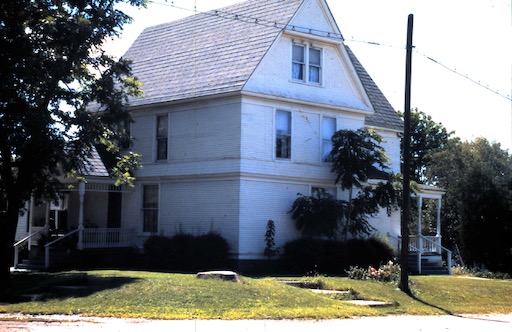
Here is his grave.

That is my neice, his great great great granddaughter standing by the monument.
This is really getting annoying.

Maybe we will get to CA by the end of June. Arizona is pretty op[en as it has a Republican Governor.
California is being held hostage by you-know-who.
I was thinking about Psychiatry today and the problems of deinstitutionalization. The best source for the latter is “My brother Ron,” by Clayton Cramer.
My book review of this book is here.
I was a medical student in 1962 when I got a summer job working in a VA psychiatric hospital doing routine physicals on the inmates. They were all men and some had been there for years. They were all “chronic hospital cases,” as described in this excellent history. Mr. Cramer gives a very thorough history of psychiatry leading up to the introduction of psychiatric drugs that actually worked and the social upheavals of the 60s that led to the emptying of the state mental hospitals. At the time I had my personal experience with the chronic schizophrenic, the deinstitutionalization movement was just getting started. My own days with these patients were similar in many respects to Mr Cramer’s experiences with his brother, Ron. Fortunately, none were my relatives and I could go home every night and leave their troubles behind. Still, the experience of talking to them all day was exhausting. My job was to do annual physicals since the psychiatry residents did not want to do so.
This was the height of the psychoanalysis influence on psychiatry. Fortunately, the chief of the service where I was working was a former analyst who realized that Freud had nothing to offer the psychotic patient. He taught me to talk to the sane part of the patient and ignore the “crazy” part. The early drugs, like chlorpromazine (Thorazine), allowed much better interaction with these chronic schizophrenics. Some of them explained what it was like to be “crazy,” their preferred term. I witnessed Electroconvulsive treatment (ECT) and saw the “lucid interval” that often followed the session. The patients usually lapsed into psychosis again after a few hours but the desire was to try to prolong the effect and this led to repeat sessions.
The author does a great job with the history and goes into far more detail on the legal aspects than I did in the chapter on psychiatry in my own book, A Brief History of Disease, Science and Medicine. He writes about “The fever treatment” that won a Nobel Prize for Wagner-Jauregg, the advocate, in the 1920s. This was a result of success with syphilis using fever when the drugs were inadequate and toxic. The legal history is important as the legal maneuvers of anti-psychiatry forces were the proximate cause of the disaster that followed. The homeless problem appeared in the 70s as the mental hospitals emptied and the former patients found nothing to replace them. The Community Mental Health Centers, as the author so well describes, were intended to take the place of the state hospitals but were never adequate, especially in the era of “talk therapy,” where a single psychiatrist could only see eight to ten patients a day.
I teach medical students and take them to the homeless shelters in Los Angeles every year so they can see where their County Hospital patients come from, and return to after hospitalization. They are able to see the futility of prescribing medicines when the patient has no clock or refrigerator to time the dose or preserve the drug between doses. The author relates the incidence of mental illness among the street population. The managers of the shelters tell me and my students that 60% of the homeless are psychotic and 60% are drug and alcohol addicts. Half of each group is both. For the first few years, we had an amazing guide, a former homeless man now working for the city. He would regale us with stories of his ten years on the street addicted to crack cocaine. He took us to shelters and to homeless hideouts where he warned us not to go there without him.
This book is a source for anyone who wants to know how things got so bad and why the families of psychotic patients are so frustrated with the “advocates” who block treatment or commitment of those unable to care for themselves. One of my students’ patients was a man with a severe leg infection that threatened amputation. He lived on the sidewalk in front of a Pasadena church. He refused parishioners’ offers of housing, telling them he was waiting for the perfect apartment. He barely kept his leg with intense treatment. After treatment, he returned to the street. This is a national tragedy and the reasons are well explained in this book. I can’t recommend it highly enough.

My experience described above was with George Harrington MD, the most impressive man I have ever met in Medicine. His obituary:
Born in Independence, Missouri, Dr. Harrington attended the University of Kansas, where he received his medical degree in 1941. He also played football for the university. He then interned in Chicago, and during World War II served in the Pacific theater as a Navy flight surgeon. He was the recipient of a Personal Citation, Distinguished Flying Cross, and four Air Medals as a result of his service. In 1946, Dr. Harrington began his residency training in psychiatry at the Menninger Foundation of Psychiatry, and became a faculty member at the Menninger School of Psychiatry. He also served as chief of professional services at the Winter VA Hospital in Topeka, Kansas and was a member of the American Psychiatric Association. In 1955, he moved with his family to Pacific Palisades, where he began private practice. He was also a clinical professor of psychiatry at UCLA and head of psychiatric services at Brentwood VA Hospital until 1965.
After he served as staff psychiatrist in charge of a research project on chronic mental illness at the Brentwood VA Hospital, his work culminated in the 1965 book, “Reality Therapy,” written by William Glasser. The book, offering a new approach to psychiatric treatment, was dedicated to Dr. Harrington. He counted many noted writers and entertainers among his patients, many of whom dedicated works to him. The playwright George Furth dedicated his Broadway play, “Company,” to Dr. Harrington, who was an avid sailor and continued this activity until his death.
Harrington was a big rugged looking guy who walked with a limp from a femur fracture incurred in an auto accident soon after he finished his residency at Menninger Clinic. He told me his father had been a minister who became a lay psychoanalyst and spent time in Vienna with Sigmund Freud. In fact, he told me that he had sat on Freud’s knee as a child. From the time he was 17 he wanted to be an analyst. His father was at Menninger hence his MD from U of Kansas. After the war, he began his residency at Menninger and found that analysis had little or nothing to offer psychotic patients. He told me that every summer, the staff psychiatrists would leave the state hospital on vacation, leaving the medical students to take over. It didn’t take long for him to realize that he was getting nowhere with psychotics using analysis. He was a funny guy with a great sense of humor and an ability to mimic.
He became a clinical professor of Psychiatry at UCLA and took over a ward at the Sawtelle VA hospital sometime before 1962 when I met him. He told me that staff at the VA were very skeptical of his new ideas on therapy so, early in his tenure, they lined up a “hard case” for him to demonstrate this new “talk therapy. ” The new drugs had made things much easier to deal with schizophrenics and he wanted to go beyond with some sort of behavioral therapy. He said the patient was a typical schizophrenic little guy. Harrington asked him how things were and the patient responded with a long stream of typical crazy talk. Harrington listened to all this, then responded that something very similar had happened to him. He then repeated almost verbatim the same stream of crazy talk the patient had related. Half way through, the patient he said began to laugh. He was no longer psychotic, if he had ever been so. He liked having a bed and three square meals a day. He had memorized enough crazy talk to keep everyone convinced that he belonged there. Harrington cautioned me that anybody who wanted to live in a nut house was not normal. Still, the guy was just not that psychotic. He convinced the ward staff that there was something to his ideas. After that, everybody on the staff was part of the treatment team. Even the guy who ran the floor polisher was invited to the Wednesday staff meeting.
What Harrington did was to set up a program of rules that taught these psychotic patients that we knew they were crazy and we were not about to throw them out into a world that scared them so badly. We also, me especially, talked to them and focused on the part that was not crazy. It could be exhausting to do so but patients would respond. One of them told me as I was leaving at at the end of the summer to go back to school that talking to me allowed more of his mind to come out of the psychosis. Of course, he didn’t put it that way but that is what it sounded like to me. It was an intense summer and George Harrington was someone I will never forget.
Most of my job was to do annual physicals on these man, many of whom had not been examined in years. It was an interesting experience to do prostate exams on these psychotic men. It turned out to be no big deal as they all appreciated someone looking after them. I even found a prostate cancer that summer. Psychiatry was still in the grip of analysis then and the residents from UCLA did not want to touch patients.
After returning to medical school, I met some academic psychiatrists and lost interest in the specialty. Harrington was almost unique although Glasser’s book, which explains much of Harrington’s methods, had a wide popularity and is still in print.
We are beginning the new year with a new dog. We lost Juliet in October and waited until we will be home for a few months to adopt a new basset hound. We went to Daphneyland shelter again where I adopted Juliet and Charlie.
Charlie was a handicapped little guy whose hind legs were in a cart at the shelter. We got him home and he was able to walk woithoput thecvart as soon as he was home.
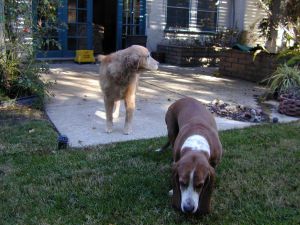
Those were his first moments at home.

Then he explored the yard.
Juliet came after we lost Winston.

She was with us for almost four years and came to Arizona with us. Last October, she got sick, first with a Horner’s Syndrome in her right eye, then a rectal tumor. We had to let her go.
Now, we have Sophie who we adopted last Saturday at the shelter. She has explored the yard, falling in the pool the first night. She won;t go near it now.

Now, she is making herself at home.

She slept in this morning.

We adopted Juliet when we lost Winston in January 2016. Winston had a lot of personality but Juliet was as sweet as Charlie was, and Charlie was an angel.
Today we had to help Juliet over the rainbow bridge. About a month ago, she developed a eye condition we learned was Horner’s Syndrome.
We took her first to our regular vet, then to a vet ophthalmologist who made the diagnosis. We concluded that it was idiopathic, meaning no specific cause, but now I wonder. The timing seems too close to be coincidence.
Anyway, last week I notice she was trying to pass a stool but nothing was coming out. Finally, she had a watery stool but I thought nothing of it. Then she began coughing and retching so I took her in thinking she might be developing heart failure. In examining her, the vet did a rectal exam and found a rectal mass. A chest x-ray showed a few infiltrates that could have been pneumonia. Her lab tests were pretty normal but she had not passed a stool, even a watery one, since last Wednesday. Today her belly was distended and she was coughing more. There was no cure but it went faster than I could have anticipated.
That was my last photo of her. Sleeping next to me, where she usually placed herself but showing her distended belly. She was a wonderful dog.
We will miss her. After Christmas, we will probably get another dog but it will be hard to replace Juliet.
My mother had a pretty interesting life. Her father was born in 1849.
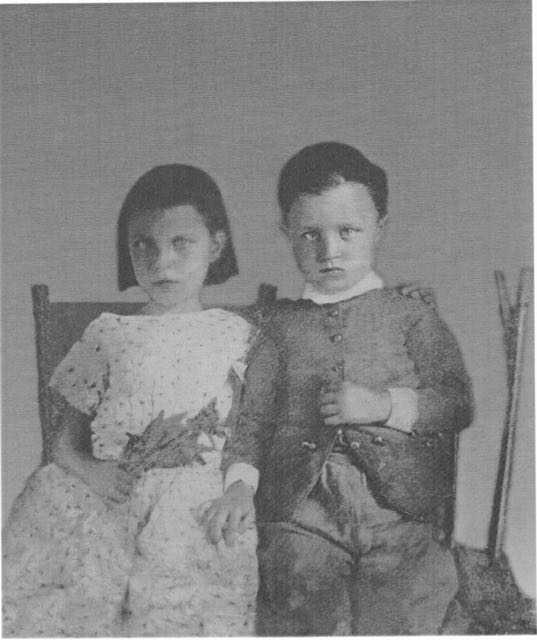
Here he is with his sister, Anna, at about the age of five or so. This is from a Daguerreotype, which was printed on a copper plate that looked like glass.
Invented by Louis-Jacques-Mandé Daguerre and introduced worldwide in 1839,[4][5][6] daguerreotype was almost completely superseded by 1860 with new, less expensive processes yielding more readily viewable images. In the late 20th century, there was a revival of daguerreotypy by a small number of photographers interested in making artistic use of early photographic processes.
To make the image, a daguerrotypist would polish a sheet of silver-plated copper to a mirror finish, treat it with fumes that made its surface light sensitive, expose it in a camera for as long as was judged to be necessary, which could be as little as a few seconds for brightly sunlit subjects or much longer with less intense lighting; make the resulting latent image on it visible by fuming it with mercury vapor; remove its sensitivity to light by liquid chemical treatment, rinse and dry it, then seal the easily marred result behind glass in a protective enclosure.
The image is on a mirror-like silver surface, normally kept under glass, and will appear either positive or negative, depending on the angle at which it is viewed, how it is lit and whether a light or dark background is being reflected in the metal. The darkest areas of the image are simply bare silver; lighter areas have a microscopically fine light-scattering texture. The surface is very delicate, and even the lightest wiping can permanently scuff it. Some tarnish around the edges is normal.
So the method was only ten years old when that image was made.
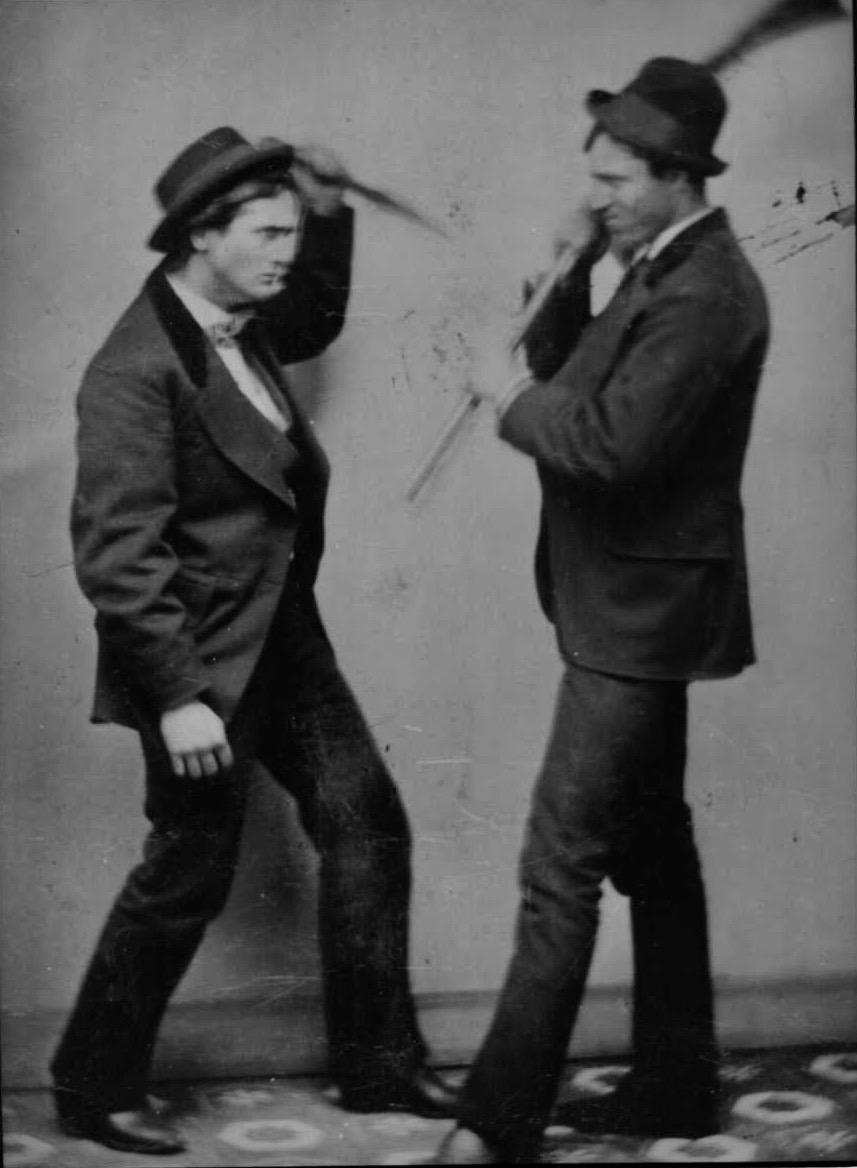
Here he is as an adult, acting in a play. There is an amazing likeness to his grandson, Arthur G Kerrison, who served in World War II.
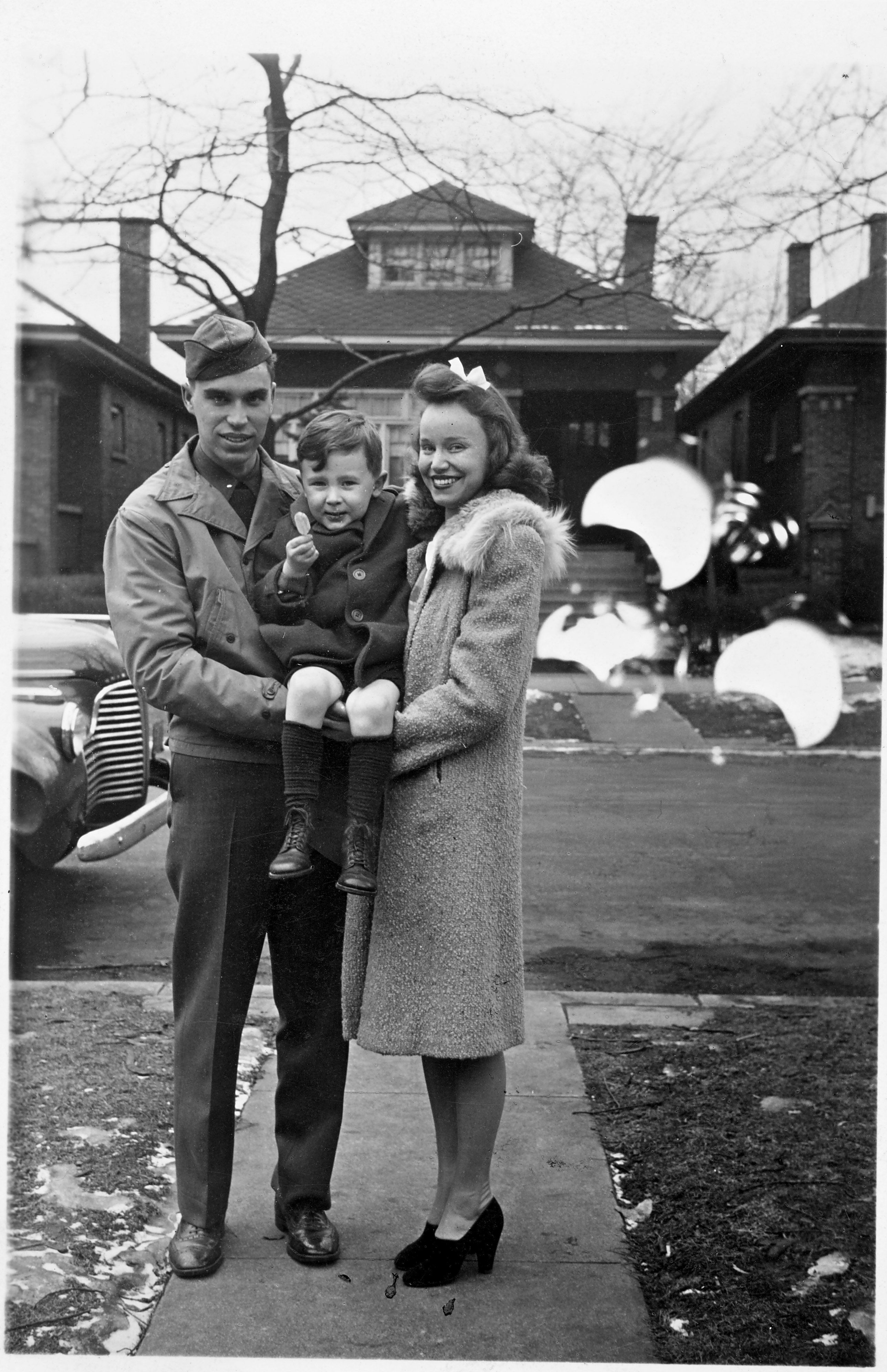
There is Arthur G, also known as “Bud,” a common nickname for a junior in those days. He is holding me up between him and his sister Marian. Another sister, Ruth, often known in the family as “Little Ruth” since mother lived with them until 1926 and was often considered an older sister.Ruth was born in 1916 when mother was 18 years old. Marian was born in 1917 so they were not that far apart in age. Ruth and Marian would later function as babysitters for me as they were 22 and 23 when I was born.
My mother’s mother was born in Canada and her birth name was “Bridget,” which she did not like and changed to “Della” while in school.

This is her photo as an adult and probably not long before she died in 1926.
She and Joseph Mileham met in Aurora Illinois where she was working and living in a rooming house owned by Joseph’s sister Anna.
They married and mother was born as the fourth child, and third surviving child, 18 months before her father died of pneumonia.
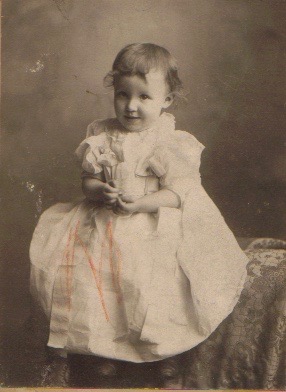
Here she is as an infant, probably around the time her father died.
Her sister is here.
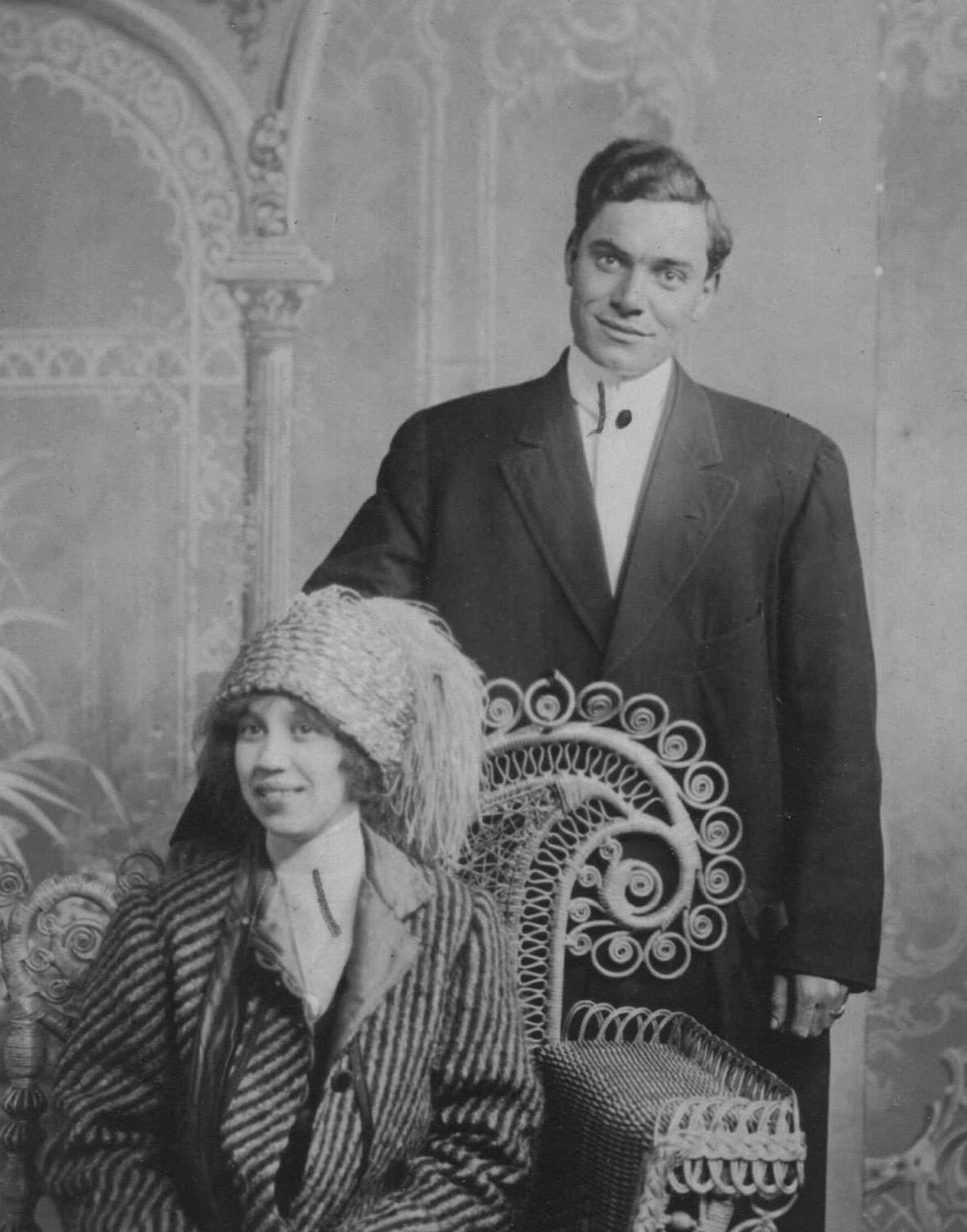
She is quite young and her husband Art is with her.
Her brother, Joseph Jr is here with his wife Marie.
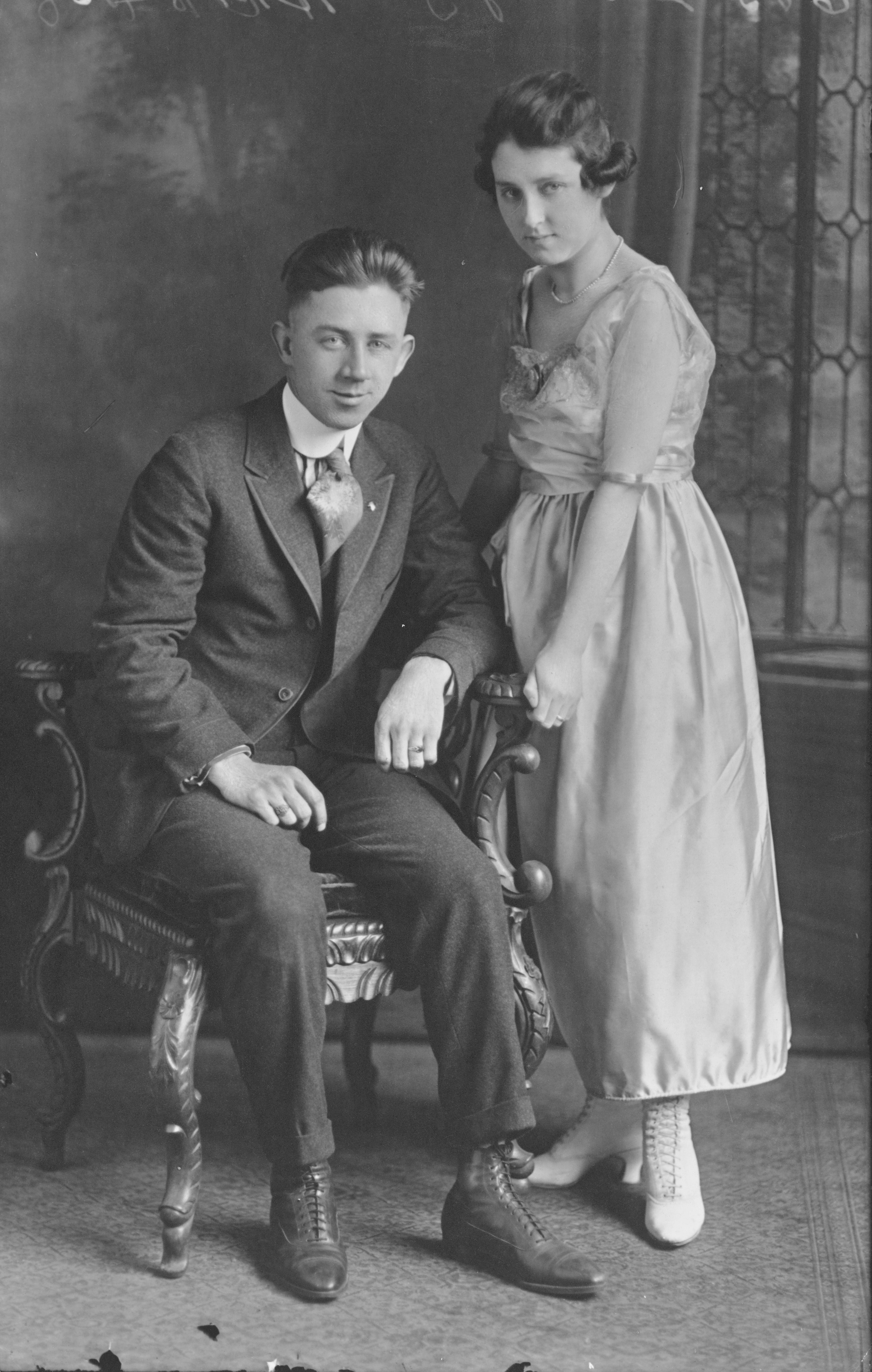
Mother at 18.
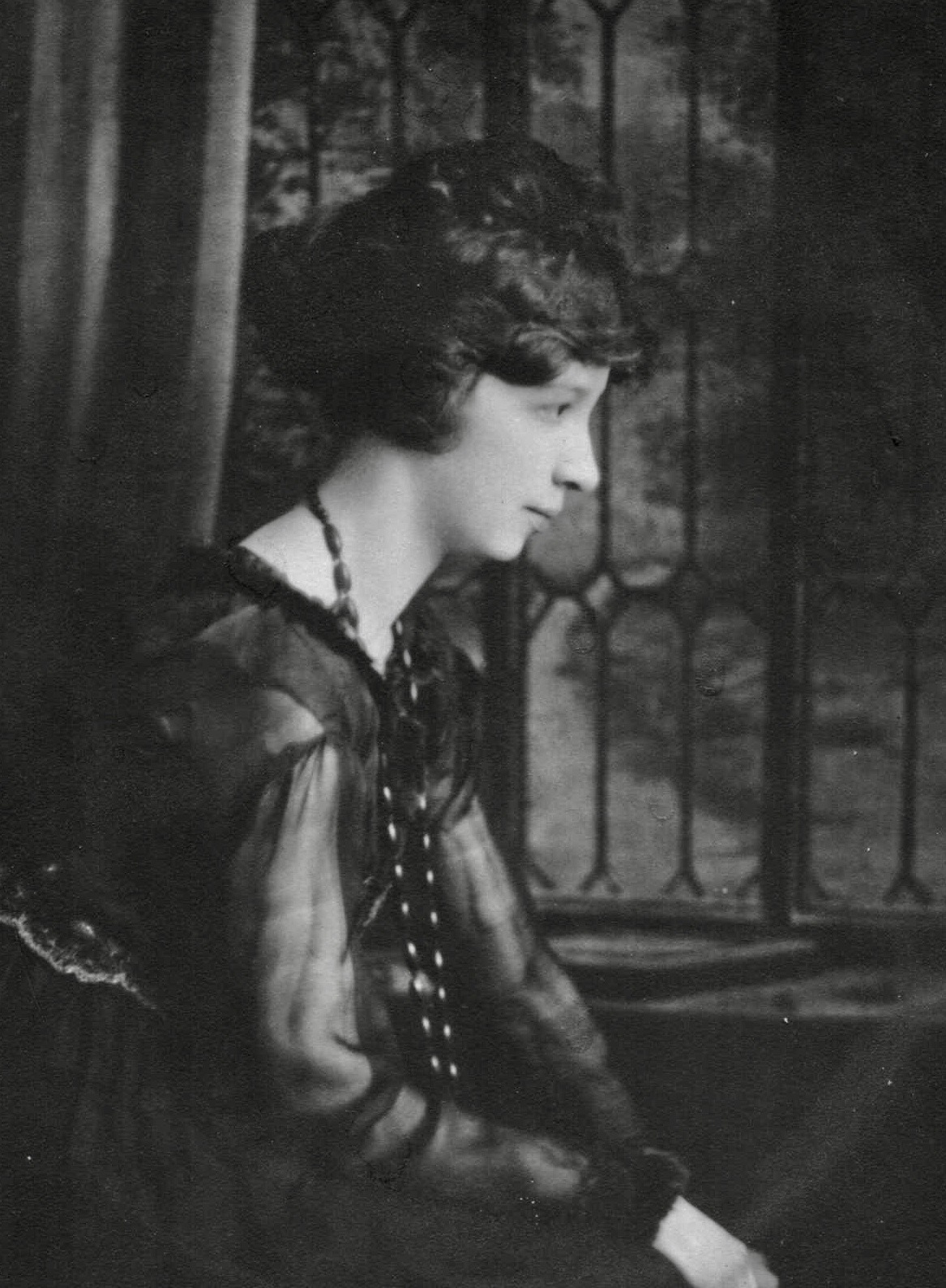
Here she is in 1925 at age 27 with two boy friends on vacation at Lake Delevan.
In 1926, her mother and brother both died. She traveled to California to stay with relatives and remained until 1929.
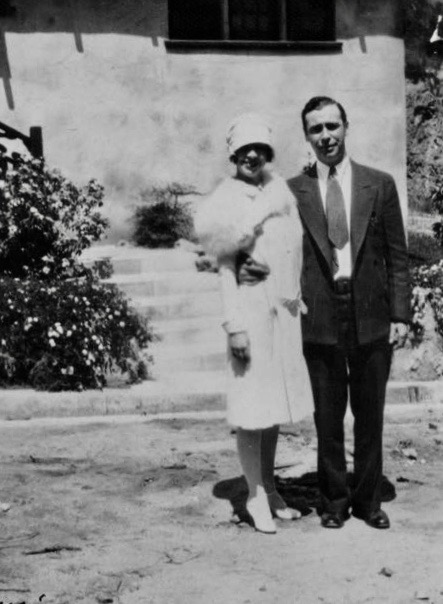
Here she is dressed as a typical flapper with her cousin, Merle McHenry. She returned to Chicago after 1929 as the McHenrys were hit hard by the Depression.
She married my father in 1937 and I was born in 1938.
Here she is with her sister and brother-in-law and with her niece Marian.
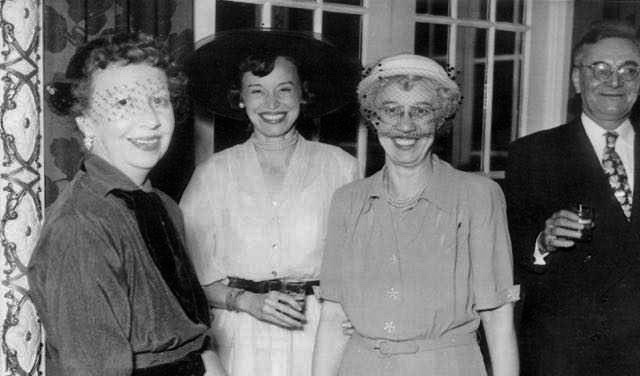
That would be around the 1960s. And here she is at her 100th birthday.

She lived a full life in three centuries. Born in 1898 and died in 2001.
I moved to California in 1956 to attend college. Los Angeles was a paradise. The weather was great. The traffic was no problem. I learned that the LAPD did not take bribes and was not amused at attempts to offer them. After growing up in Chicago, I had learned to put a ten dollar bill behind my drivers’ license in case I was stopped. In Los Angeles, I did so and was lectured about the consequences of offering a bribe by a stern LAPD officer.
I lived in the fraternity house and one year slept on an outside second floor porch. I had four blankets on my bed but no problem, with flies or mosquitoes. I remember flying back to Los Angeles one New Years Eve from Christmas vacation in Chicago. The palm trees told me I was home. There was a brush fire in the hills but it was nice to be back. I would sometimes drive up to Sunset Boulevard just to see the city at night. The TV show, “77 Sunset Strip” showed just what it looked like. We would drive into Hollywood and sometimes eat at Villa Frescati. We had a lot of fun. Too much fun as I lost my scholarship.
The first sign of trouble was described in Victor Davis Hanson’s book, “Mexifornia.” There was trouble before that as the Watts Riot in 1965 began the endless pandering to the angry mobs.
The Rodney King riot in 1992 was another harbinger of trouble. The LAPD officers who saved Rodney King’s life by taking him down without significant injury before Melanie Singer shot him, as she planned to do before they arrived, were rewarded with prison sentences from the second trial. Double Jeopardy was not outlawed in the Clinton Administration. By that time, I was nearing retirement as my back injury was affecting me.
I had lived in Orange County for 20 years at that point and it was still a great place to live. After my back surgery, I spent a year in New Hampshire. Had my grant come through, I might have stayed, at least for a few years. I returned thinking I might have a second career in administrative medicine. I did work part-time reviewing workers comp claims but the career in measuring medical quality never got started.
The decline of California has become more and more apparent. Even the hospital in Orange County where I had practiced for 20 years has entered a period of decline.
In 2008, we began to see the anticipation of Obamacare. Hospitals began to expect tighter margins and, being the most incompetently managed large organizations in the US, they decided to reorganize with little idea of how to do so. They expected that vertical integration would increase their profits (Which are as large in non-profits and in for-profits) so they spent millions to buy the medical practices of doctors on the staff. This put the doctors on salary and bonus systems but there was a natural conflict of interest. Doctors had for many years been the object of frustration and even hatred from hospital administrators. We don’t take orders well and many resisted the efforts of the hospital to make us order either more tests,
Doctors in urban areas, or even deeply populated suburban areas, are employees. The days of independent practice are mostly gone.
In 2017, we left California for Arizona where I had had a weekend home for years. I still subscribe to the local Orange County newspaper where I can read stories like this one, and this one.
I used to take my medical students to homeless shelters in downtown Los Angeles to see how County patients lived. Now “the homeless” are everywhere, defecating on the streets of San Francisco. A medical group, probably the American College of Surgeons, cancelled their San Francisco convention last year.
The neighborhood’s open drug use and tent encampments, among other issues, are what allegedly prompted the unidentified medical group to call it quits with SF, even though the city spends approximately $300 million to help the continuing crisis.
“It’s the first time that we have had an out-and-out cancellation over the issue, and this is a group that has been coming here every three or four years since the 1980s,” Joe D’Alessandro, president and CEO of S.F. Travel, tells San Francisco Chronicle’s Matier and Ross.
The ACS Clinical Congress has been there every three years since the 1960s. No more.
Then the neglect of infrastructure was emphasized by the 2017 Oroville Dam failure.
In February 2017, Oroville Dam’s main and emergency spillways were damaged, prompting the evacuation of more than 180,000 people living downstream along the Feather River and the relocation of a fish hatchery.
Heavy rainfall during the 2017 California floods damaged the main spillway on February 7, so the California Department of Water Resources stopped the spillway flow to assess the damage and contemplate its next steps. The rain eventually raised the lake level until it flowed over the emergency spillway, even after the damaged main spillway was reopened. As water flowed over the emergency spillway, headward erosion threatened to undermine and collapse the concrete weir, which could have sent a 30-foot (10 m) wall of water into the Feather River below and flooded communities downstream. No collapse occurred, but the water further damaged the main spillway and eroded the bare slope of the emergency spillway.
This year is another wet winter and the dam has probably not been repaired. Nothing is fixed as the state declines into decrepitude.
Victor Davis Hanson sums it up.
California ranks first among the states in the percentage of residents over 25 who have never finished the ninth grade— 9.7 percent of California residents, or about 4 million Californians. It also rates 49th in the number of state residents who never graduated from high school — or about 18 percent of the current population.
In other words, about 7 million Californians do not possess a high-school diploma, about equal to the size of the nine counties of California’s Bay Area, roughly from Napa to Silicon Valley. In some sense, inside California, there is a shadow state consisting of high-school dropouts that’s larger than 38 other U.S. states.
A large share, if not the majority, are illegal aliens.
What is going on?
Three concurrent — and yet antithetical — trends explain the malaise, though they’re rarely talked about. Indeed, one of the landmarks of the new California mentality is denial and self-righteousness that assume it is illiberal to notice that a quarter of the nation’s homeless population sleeps on California streets, or that violent crime is 20 percent higher in California than the national median, or that San Francisco ranks No. 1 in per capita property crime rates of all the nation’s largest cities.
The result ?
The Grapes of Wrath — in Reverse
Second, in the last decade and a half, about 6 million Californians over the age of 25 left the state; in the last 30 years, perhaps 10 million fled. There are no accurate statistics on the political ideologies of the departed or even their actual numbers. But most studies suggest that the reasons for radical outmigration were quality-of-life complaints, soaring home prices and taxes, poor state services, failing infrastructure and schools, and rising crime.
Joel Kotkin has a new piece in City Journal That should worry California politicians.
a new Brookings study shows, millennials are not moving en masse to metros with dense big cities, but away from them. According to demographer Bill Frey, the 2013–2017 American Community Survey shows that New York now suffers the largest net annual outmigration of post-college millennials (ages 25–34) of any metro area—some 38,000 annually—followed by Los Angeles, Chicago, and San Diego. New York’s losses are 75 percent higher than during the previous five-year period.
They are too dense and too arrogant in their ignorance to notice.
We left and are happy in Arizona. We are close enough to drive over for birthday parties. Our home in Tucson would be more than a million dollars in Orange County if we could even find a one acre lot.
Tucson has an Opera and the University of Arizona is here. I am sad to see what has become of California. It was a wonderful place when I was going to college and for decades after. The insanity that has gripped the state seems to be a development of the past 25 years. Jerry Brown and his obsession with global warming is part of it. The massive influx of illegal aliens is another part. I doubt it can be salvaged in my lifetime.

November 11 is the 100th anniversary of the end of World War I. When I was a child, it was Armistice Day. In Britain, it is still Remembrance Day when people who respect history buy and wear paper poppies.
The story of the poppies is told here.
In the spring of 1915, shortly after losing a friend in Ypres, Canadian doctor Lieutenant Colonel John McCrae was inspired by the sight of poppies growing in battle-scarred fields to write the now famous poem In Flanders Fields.
His poem moved American teacher Moina Michael who began making and selling silk poppies to friends to raise money for the ex-service community.
Before long, poppies made their way to the UK and became the symbol of the Royal British Legion when it was formed in 1921.
The first ever ‘Poppy Appeal’ in the UK that year raised over £106,000 for war veterans. The following year, a poppy factory was set up by Major George Howson MC, giving jobs to disabled former servicemen.
The bright red poppy is regarded as a resilient flower which managed to flourish despite fields being destroyed by war.
Some people say you should wear the poppy on your left side, so it is worn over the heart. The left is also where military medals are worn. Others say only the Queen and Royal Family are allowed to wear a poppy on the right, which is an urban myth.
About ten years ago, my daughter Claire and I were visiting London and a friend, a retired Royal Army Medical Corps doctor, invited us to sit in Westminster Abbey with the RAMC on Remembrance Day. The group sits in front of the RAMC window that commemorates the medical branch of the British Army. The medical corps is “Royal” but the Army is of Parliament, so not “royal.”
In the north aisle of the nave of Westminster Abbey is a memorial tablet and stained glass window for those who died serving in the Royal Army Medical Corps in the 1914-1918 and 1939-1945 wars. The larger white marble tablet was unveiled on 13th July 1922 by the Duke of Connaught, Colonel in Chief of the Corps. It was designed by F.J. Wilcoxson. The inscription reads, below the regimental badge:ROYAL ARMY MEDICAL CORPS
In memory of 743 Officers and 6130 Warrant Officers, Non-Commissioned Officers and Men who fell in the Great War, and whose names are enrolled in a Golden Book placed in the Chapter House. “They loved not their lives unto the death”
World War I changed Europe and we live with its consequences today. Unfortunately, the study of history has lapsed largely, and is distorted by academics and politics.
In years since that visit, I have spent some time in the scenes of World War I, such as Ypres, a scene of a prolonged and expensive battle of the war. There were several battles of Ypres.
The first ended the German assault through Belgium and ended with the beginning of trench warfare that continued to the end of the war. On our visit in 2015, we saw some of the original trenches, which were preserved by a family that returned after the war to find their farm a battlefield. They elected to preserve the scene as a museum since farming would be difficult with all the residue of battle and the bodies of the dead. There children have continued the museum and it is quite an interesting visit.
There are a number of museums in the area. This is the one we visited.
After the First World War a farmer returned to reclaim his land in and around what was left of the wood he had left in 1914. A section of the original wood and the trenches in it were cleared of debris and casualties but generally the farmer left a section of a British trench system as he found it.
This site is now one of the few places on the Ypres Salient battlefields where an original trench layout can be seen in some semblance of what it might have looked like. Elsewhere the trenches were filled in and ploughed over by returning farmers leaving only the occasional chalky outline of what had once been there.
In the last decade there has been a large increase in visitors to the Ypres Salient, and many have, of course, included a visit to the trenches at Sanctuary Wood. In the 1990s the trenches were covered in grass and the whole site was overgrown with undergrowth. Interestingly, nowadays the ground around the trench line has been visited by so many pairs of feet that it is mostly bald with no grass or undergrowth. The photograph on the far right shows how the trenches looked just a few years ago.
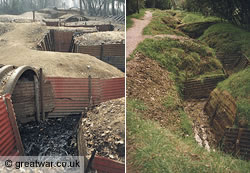
The changes with increased foot traffic are seen in the two photos. The left photo is the way we saw it.